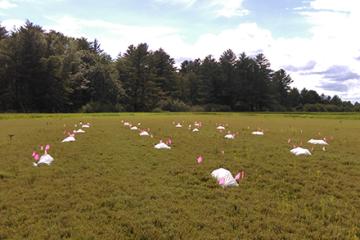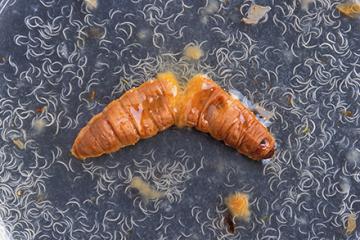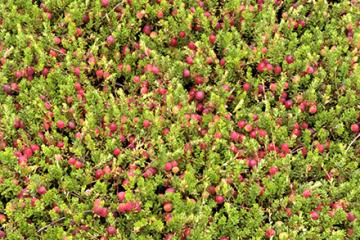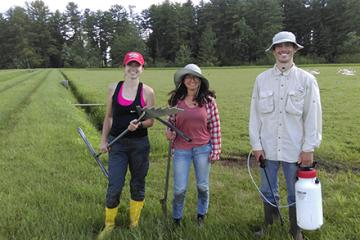USA
October 1, 2024
As scientific sleuths, ARS researchers continually seek new natural methods to help farmers grow and maintain healthy crops.
ARS entomologists David Shapiro-Ilan and Shawn Steffan have developed a unique process that enables farmers to raise their own nematodes, a type of worm that can serve as an environmentally friendly biopesticide and offer a natural solution for insect pests.

Early field trials with beneficial nematodes. (Photo by Shaw Steffan, ARS)
“In Byron, GA (at the Southeastern Fruit and Tree Nut Research Station), we do a lot of work on entomopathogenic, or beneficial nematodes, which are small round worms,” said Shapiro-Ilan. Entomopathogenic nematodes are used to control a wide array of economically important insect pests such as fungus gnats, white grubs, thrips, citrus weevils, peachtree borer, and pecan weevils, etc. Opposed to some nematodes that are harmful to plants or mammals, these only kill insects, that’s why they are used as natural biopesticides.”
According to Steffan, when applied to crops, the nematodes can act as a broad-spectrum biopesticide.

Entomopathogenic nematodes emerging from an infected larva of the greater wax moth. (Photo by Peggy Greb, ARS).
“We have yet to find an insect pest the nematodes won’t kill and eat, and so for cranberry and blueberry growers, or for any U.S. crop where the nematode is placed in contact with the insect host, there is the potential to kill that host,” he said.
Nematodes are effective biocontrol agents because they use their built-in partner, symbiotic bacteria, to assist in killing insect pests. As a nematode invades an insect host, it releases the bacteria, filled with toxins. While researching the nematode’s basic biology and ecology, Shapiro-Ilan said he discovered some unique characteristics.
Because nematodes are sensitive to UV radiation, the ARS team created nanoparticle and gel formulations to protect the nematodes when they’re applied above ground.
“The nanotechnology provides each nematode a ‘suit of armor,’ shielding it from the sun,” said Shapiro-Ilan. “Nematodes move in the soil like a pack of wolves, trying to find their prey. They also communicate with each other through pheromones, so we are applying specific pheromones to enhance their efficacy. We expose nematodes to the pheromones to tell them it’s time to find another insect to kill. We are finding they do better with these pheromones than without.”

Cranberry canopy from a Wisconsin cranberry marsh. (Photo by Shaw Steffan, ARS)
Together with Steffan, who is based at the Vegetable Crops Research Unit in Madison, WI, Shapiro-Ilan is also generating a more robust and cost-effective way for farmers to activate their own environmental pest control for a variety of crops. It involves formulating and mass-producing nematodes through a ‘do-it-yourself’ process.
“In addition to the gels, we have developed a new methodology with which farmers can grow their own nematodes inside insects,” Shapiro-Ilan said. “This will allow a farmer to inoculate mass numbers of insects, and then harvest the nematodes before applying them to the field or pasture. Shawn [Steffan] has been successful in assisting cranberry farmers in Wisconsin in producing the nematodes on their own. Now we are developing this in Byron, GA, for peach and pecan farmers.
“What’s great about nematodes is that they will attack native pests of a native North American crop, such as cranberries,” added Steffan. “We’ve discovered the nematodes are highly virulent against cranberry pests, such as the flea beetle and three species of invasive moths.”
Steffan’s team is working with a handful of Wisconsin growers who are currently producing large numbers of nematodes in-house, in the hundreds of millions.

Stephanie Rink, Natalie Eisner and Shane Foye, from the University of Wisconsin, are part of the Bioinsecticide Team assisting with field work for ARS Vegetable Crops Research in Madison, WI. (Photo by Shawn Steffan, ARS).
“That in itself is a success, but we’re also trying to scale up,” Steffan said. He added that it typically takes 25 to 26 million nematodes-per-acre to protect a specific crop. Commercially, the recommended number of nematodes is 1.5 billion-per-acre.
Many companies currently producing beneficial nematodes use artificial media to grow the nematodes in fermentation tanks. But Shapiro and Steffan say that approach is out-of-reach to farmers as start-up costs are high. Also, a certain level of expertise is required for fermentation technology.
“The grower-based methods we’ve developed allow the farmers to produce high quality nematodes with ease,” said Steffan. “Ultimately our goal is to have growers mass-propagate nematodes on their own. That way they will have a biopesticide readily available to treat hot spots [of invasive pests] around their cranberry marshes, or on their farms.” (In Wisconsin, cranberry farms are called marshes, not bogs).
Initially, Shapiro-Ilan and Steffan’s research was published in the Journal of Insect Science in September 2023. They are now working to create a step-by-step instructional video for farmers to self-produce beneficial nematodes to protect their crops. — Tami Terella-Faram, ARS Office of Communications.